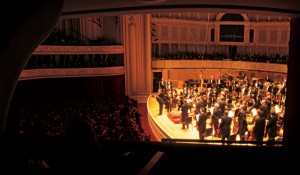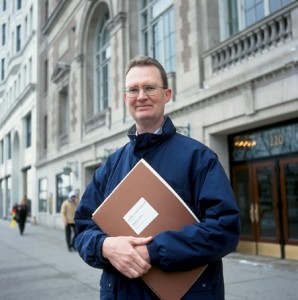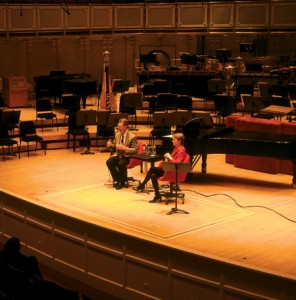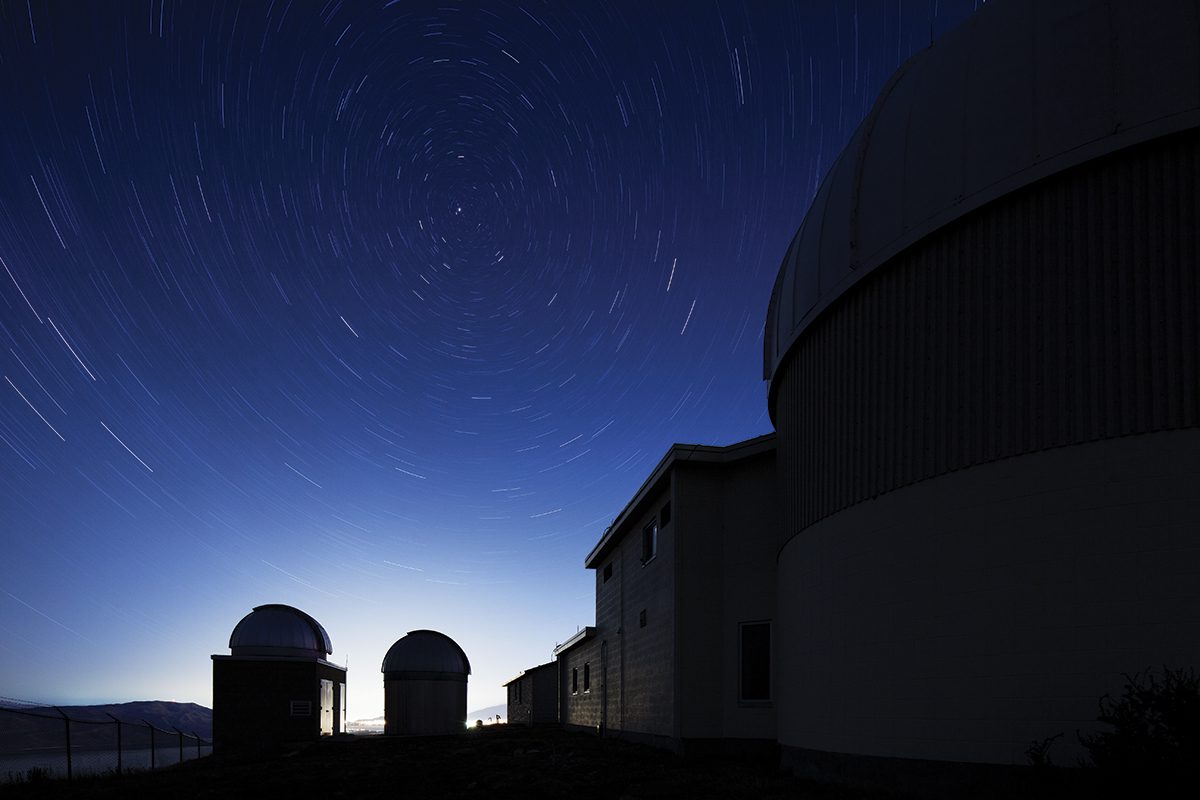A passion for sound led composer Stephen Jones to a coveted spot on one of the music world’s premiere stages.

Jones accepts warm applause after one of the performances. Photo by Bradley H. Slade, ’94.
One January night in 1920, Sergei Rachmaninov stepped out from the darkness backstage into the brilliant lights of Chicago’s Orchestra Hall. The Russian pianist and composer had traveled to Chicago to perform his Piano Concerto no. 3 in D Minor, a piece he wrote in 1909 that has come to be known as one of the most technically difficult and lengthy piano works in history.
In January 2004 the Chicago Symphony Orchestra performed the formidable concerto again, but before Rachmaninov’s third began, applause greeted a young, emerging composer from the West. After the final notes of his latest work resounded through the hall, Stephen M. Jones, ’83, a tall, thin BYU music professor, stepped onto the same illustrious stage to receive praise for the world premiere of his orchestral composition at the exactest point. The performance was a realization of Jones’ lifelong dream to hear his music performed by one of the best orchestras in the world.
A commission from the Chicago Symphony Orchestra (CSO) is a celebrated achievement. “I have no doubt that Stephen is the envy of most young composers,” says Claude Baker, professor of composition at Indiana University. “A premiere with the Chicago Symphony is widely publicized and brings great prestige not just to Stephen Jones as an individual but also to Brigham Young University.”
The CSO, founded in 1890, is known for its international awards, virtuoso appearances, and worldwide tours, and its recordings have earned 56 Grammy Awards. With its reputation for promoting innovative new music, the Chicago Symphony Orchestra has commissioned a significant amount of well-regarded musical literature. Augusta Read Thomas, the orchestra’s composer-in-residence since 1997, helped select Jones to receive the CSO commission for at the exactest point. “This is a dazzling, beautiful, personal, and well-built piece,” she says. “It really is very special.”

On a cold January day in Chicago, Stephen Jones arrives at the Chicago Symphony Center to help the orchestra prepare for the world premiere of his work at the exactest point. Photo by Bradley H. Slade, ’94.
Transformed By Music
The newly appointed dean of BYU’s College of Fine Arts and Communications, Stephen Jones has been in love with music for as long as he can remember. When he was 9 years old, his parents bought a used piano, and he discovered his passion for sound. “I had an excellent first teacher, who taught me a lot about theory, harmonizing melodies—just opened my world,” he says.
Growing up in Salt Lake Valley, he began frequenting a local music store, and as a 12-year-old, Jones sought employment to support his musical habit. “The folks at the music store put me to work washing windows so that I could buy my sheet music.” Remnants of that collection are still in Jones’ possession, and he glowingly recalls when the owner’s son invited him to hear the Utah Symphony perform. “My life was absolutely transformed when I heard an orchestra play. I watched Maurice Abravanel conduct the Utah Symphony, and I knew I was at home.”
As Jones grew older he began driving himself to the concerts, and his parents bought him season tickets as a gift. The observant young man noticed there were concerts in which the conductor programmed new music—and that the hall wasn’t always as full on those evenings. Those performances, however, fascinated Jones. “There was something about exploring new works by unknown composers that really interested me, and I began to think seriously about writing and composing.”
Jones’ early compositions included piano and choral pieces, which were often performed by groups at his high school or by himself in various competitions. He studied music at BYU and the University of Cincinnati’s College-Conservatory of Music.
At Cincinnati he met Bernard Rands, a Pulitzer Prize–winning composer who spoke to a group of composers at the school. “He actually used the word God,” Jones remembers. “He talked about music as a way of connecting to a higher power. That is so rare in the arts today. There was a depth to his person that immediately attracted me.”
When Jones approached Rands about opportunities to learn more from him, the composer invited Jones to apply to Colorado’s Aspen Music School, where Rands taught in the summers. The musicians became friends during two summers at Aspen. “Bernard has really been a mentor to me—much more than just a composer whose work I’ve admired,” says Jones, who later brought Rands to BYU for a symposium dedicated to Rands’ music.
Jones’ own work has come to reflect the philosophy of his mentor—that deeper themes of morality and God should be a part of music. Fellow musicians use the word personal to describe Jones’ compositions. “Stephen writes music that comes from a very deep place within the soul of the composer. When you get to know his music, you get to know him,” says Jack Delaney, director of bands at Southern Methodist University (SMU). “I’ve never heard one score of his that sounded like he was just ‘doing his job.’ I sense that for him, music is a higher calling.”
Commissions began coming to Jones while he was at Cincinnati in the late 1980s, and the flow continued when he joined BYU’s faculty in 1991. He has written pieces for the Cincinnati Chamber Orchestra, the Utah Arts Festival, and several university ensembles. His orchestral work Sing the Earth won a Judges’ Commendation for Excellence in the 1995 Barlow International Competition.
It was Sing the Earth that caught the attention of the Chicago Symphony Orchestra in 1997. Numerous hopeful composers routinely submit their work to the CSO with never-realized visions of grandeur. But soon after circulating recordings of his work for consideration, Jones was contacted by the CSO’s Augusta Read Thomas. “I listen to everything that comes in,” Thomas recalls, “and it definitely stood out in the pile. Sing the Earth is a very musical, sensitive, and well-made piece.” She asked Jones for permission to submit his samples to the CSO music director, celebrated pianist and conductor Daniel Barenboim; Jones euphorically agreed, and Barenboim selected Jones to receive a commission for an orchestral score from the Ernst & Young Emerging Composers Fund.

Before each of the three performances that week, Jones and Augusta Read Thomas, the orchestra’s composer-in-residence, spoke to the audience about the music. Photo by Bradley H. Slade, ’94.
The Journey of the Music
Modern composers use advanced notation software and recording equipment—luxuries Beethoven and Mozart never enjoyed. “Long gone are the old days of the quill and ink on parchment paper by the babbling brook,” laughs Indiana professor Claude Baker.
Still, Jones always begins composing with just a sheet of paper and the conceptual idea. “Any artist that makes things from blank paper—and creates a whole symphony out of nothing—stands out for the sheer tenacity of doing that,” says Thomas.
An orchestral score has 35 to 40 lines, representing the various instruments, and the composer decides which lines to fill across 20 minutes of time; there are tens of thousands of decisions to make. “You can easily get lost and frustrated,” says Jones. But after a lot of head scratching come those welcome, revelatory moments. “There’s a sense of arrival, a feeling of clarity about the music that gives you joy and understanding.”
Jones’ composition for the CSO began with that very idea: a point of arrival and clarity. The title for at the exactest point sprouted from a poem by Wallace Stevens, “An Ordinary Evening in New Haven.” The poem describes a quest for “the poem of pure reality, untouched / By trope or deviation,” an object “at the exactest point at which it is itself, / Transfixing by being purely what it is.” The idea was striking for Jones, and it reflected his goal for the CSO commission: to create a piece through which the audience would experience a feeling of pure and clarifying arrival at that “exactest point.”
A sabbatical in 2000 allowed Jones to begin his composition. He spent his days at the piano in his office or with a small keyboard in a faculty research room in the library. “Composing can be a very lonely thing. You’re alone in a room with a piano and paper,” says Jones.
On several occasions Jones called on colleague Murray E. Boren, ’75, for advice and direction. “Murray has been someone—since I was a student—who is extremely gifted at helping others without ever dictating,” he says.
Jones’ style of careful composing is reflected in the music, says Boren, a BYU assistant professor of music. “Jones has a precise specificity to his composing that gives the works great clarity, even at their most complex moments,” he says. “His scores are encrusted with details, which give the sounds nuance and dimension. His music is controlled and beautiful.”
Though Jones begins his compostions on paper, eventually he orchestrates the music onto his laptop computer, which is connected to a musical keyboard. The process involves a lot of back-and-forth work between paper, computer, and keyboard. For Jones, composition “involves a striving—a working out of ideas and their interrelationships, of attempting to find a way to arrive at a point at which things fit exactly and the reasons for the ideas and journeys of the music are fulfilled,” he wrote in the program notes for at the exactest point.
After the composition was complete, Jones’ musical journey continued in Chicago, where he traveled in January for a week of rehearsals and the world premiere of at the exactest point.
For a composer, first rehearsals can be difficult because the piece does not yet have the desired sound or shape. After the primary rehearsal, guest conductor Sir Andrew Davis, music director of the Chicago Lyric Opera, invited Jones to spend some time with him to have, in Davis’ words, a postmortem. “I was able to sit and talk with him about tempi and specific things that ought to be emphasized more,” Jones says, “and to talk through what he might do to help the orchestra realize what may not be clear from the score’s parts.”
This collaborative meeting with Davis was a highlight of the experience for Jones. He fondly recalls the way he and the conductor labored together to find just the right dynamic for one point in the music. “The middle section opens with an English horn solo. I started it off in the lowest part of the register, and it just wasn’t speaking right. It was supposed to be the most prominent part,” says Jones.
The conductor worked to get the strings to play more softly, but the English horn was still drowned out by the strings’ note sequences. After the first rehearsal, Davis and Jones discussed muting the strings, but Jones decided against it.
In the next day’s rehearsal, the conductor worked again at softening the strings. Davis would “look back at me and say, ‘Is it sounding right?’ and I’d say, ‘No, still softer,’” recalls Jones. “After working for a bit, he turned and said, ‘Would you like to try it muted?’” Jones felt it was worth a try. “Within 10 seconds, both he and I knew that was it.”
Jones believes the experienced conductor probably knew all along that playing more softly was not the answer. “But he didn’t force it on me,” Jones says. “He allowed me, invited me to make the artistic choice.”
World Premiere
Chilling weather overtook the Windy City in the days leading up to the premiere. The lights of downtown Chicago lit up the frozen shore of Lake Michigan, and a fresh fall of snow lined the streets leading to Symphony Center. That weekend, music aficionados were ushered into the building by freezing temperatures, checking in their fur coats and picking up complimentary lozenges before taking their velvety seats in the historic hall. The only empty chairs were in the far corners of the highest of Orchestra Hall’s three balconies.
Jones’ piece was first on the program, scheduled to be followed by selections from Prokofiev’s Cinderella and Rachmaninov’s Piano Concerto no. 3.
Davis entered the hall, stepped onto the brick-red podium, and accepted the audience’s welcoming applause. With a sweep of his hand, he turned and readied the orchestra. An energetic upbeat gave only split-second warning for a burst of sound from the CSO’s legendary brass section.
The “strong, bold declaration from the trombones,” as described by Jones, inaugurated the first of three movements in at the exactest point. Played without pause, the piece ran for about 18 minutes. The driving rhythm of the first movement was influential, repetitive, and insistent, reappearing throughout the score.
The second movement was lush and florid with a captivating cello solo. Chicago Sun-Times music critic Wynne Delacoma described this section as “introspective,” adding, “While the violins shifted and shivered like a fog rising from a vast, icy lake, woodwinds drifted in on warmer, more gentle zephyrs.” At the movement’s end, a harp ticked away a simple, clocklike melody. “I love that moment,” says Thomas. “It’s gorgeous, timeless, and resonant.”
The final movement was the longest, “a series of sections that are revisited, investigated, and interrupted,” wrote Jones in the program notes. The music’s search for its own meaning finally arrived at its conclusion, he explains: “The last movement is like a development section of a classical sonata; it throws about all these materials, trying to find some conclusion or meaning from them. In the end, it’s the opening tune that really comes back and wins the day.”
The music was presented on three successive evenings, Jan. 8, 9, and 10; the last performance stood out as the strongest, says Jones. “After taking our final bows on Saturday night, the conductor walked off the stage with me and immediately said, ‘That was it! That was the best one.’”
Davis says Jones’ work takes listeners on a journey. “You feel you’ve experienced something,” he says, describing some portions as energetic and others as transcendent. The whole, he says, has a good shape. “The audience is carried on by the fact that the structure of the piece is clear and has a sense of direction. I think that’s very satisfying.”
Both the public and the orchestra responded warmly to the music. “After every performance I saw that weekend,” recalls SMU’s Delaney, “there were a dozen wind and brass players putting their instruments down to applaud when Stephen came on stage, and the vast majority of the string players were tapping their bows on their music stands.”
Friday’s performance was followed by a public reception at Rhapsody, a restaurant adjoining Orchestra Hall in Symphony Center. At the celebration, Jones’ admirers formed a line to congratulate the composer. “I was just shocked at how many people came up to me during intermission and the reception and expressed really having enjoyed the music,” he says.
The music critics of Chicago gave at the exactest point mixed reviews. Delacoma, of the Sun-Times, was positive, praising Jones for having “proudly grounded at the exactest point in traditional tonality and harmony while managing to avoid the formulaic.”
Chicago Tribune critic John von Rhein described Jones as “a canny orchestrator with an ear for vivid instrumental colors and quirky, fantastical rhythms.” But he set up his review as a competition between Jones and Rachmaninov, stating that “the present could compete only feebly with the mighty behemoth of the past.”
An experienced composer, Jones took the reviews in stride, though not without disappointment for von Rhein’s reaction. “He just didn’t like the piece a whole lot,” he says.
For Delaney, the reaction of accomplished performers in the orchestra was more important: “To watch all of these great musicians literally embrace Steve and his music, privately and publicly—that was the only review he needed.”

Though modern technology allows him to use computers electronic keyboards, Jones still begins his composition work on paper. The commission from Chicago Symphony Orchestra was a coveted honor for Jones, who is the new dean of BYU’s College of Fine Arts and Communications. Photo by Bradley H. Slade, ’94.
Tradition and Authenticity
As both an academic and a composer, Jones is keenly aware of the preservation and extension of culture through the fine arts. In the program notes for at the exactest point, Jones expressed his desire that “listeners will hear in my work a music that is lyrical and solidly connected to the principles of the past, but that is also new.”
Jones explains that many young composers are often primarily concerned about originality. “It’s probably good and natural for students to be looking for their own unique identity, to find their own interests and express those things in music or in other arts. But now, having gone through that stage, I’m probably less concerned with originality and more concerned with what I call authenticity,” says Jones, whose influences include Debussy, Mahler, and Stravinsky. Rather than overthrow tradition, he says, “I want to value tradition and want to be seen as speaking out of and extending that tradition.”
The power of music—and other arts—to communicate is particularly important to Jones as dean of BYU’s College of Fine Arts and Communications. After accepting the appointment, he told the college’s faculty, “This college holds the power to shape the Church in a way no other college can.” Later he explained that he was not implying superiority, but rather alluding to the college’s unique ability to reach out in the form of creative, artistic endeavors, “learning how to compose and perform in expressive ways that represent the deepest and most noble, powerful sentiments of human existence—sentiments that express joy and sorrow and the power of our feelings about our Heavenly Father.”
Those life-reflecting sentiments will play a role in four new works commissioned by the Barlow Endowment for Music Composition at BYU to commemorate the 200th anniversary of Joseph Smith’s birthday in 2005. As one of the four composers, Jones was commissioned to write an orchestral piece for the BYU Philharmonic Orchestra.
The Barlow commission will employ Jones’ distinct ability to give his music an inner lining of spirituality. At a preconcert lecture in Chicago, Jones described himself as a very spiritual person. “I cultivate the faith that I practice. I know it finds its way into the work, but it’s not a conscious thing,” he said. “I don’t try to infuse my work with religion. I try to infuse my life with that, and then out of my life, I write music.”
Jamie Montague Callister, a former BYU Magazine intern, is a graduate student at the University of Chicago.
A recording of at the exactest point is available at BYU’s music: www.byumusicstore.com/at-the-exactest-point. For more about Stephen Jones’ music see stephenjonesmusic.com.
Feedback: Send comments on this article to magazine@byu.edu.









